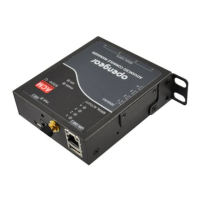Terminology
326 Console Server & RIM Gateway User Manual
Point-to-Point Protocol. A networking protocol for establishing simple links between two peers.
The Remote Authentication Dial-In User Service (RADIUS) protocol was developed by Livingston Enterprises as an
access server authentication and accounting protocol. The RADIUS server can support a variety of methods to
authenticate a user. When it is provided with the username and original password given by the user, it can support
PPP, PAP or CHAP, UNIX login, and other authentication mechanisms.
A network device that moves packets of data. A router differs from hubs and switches because it is "intelligent" and can
route packets to their final destination.
Subscriber Identity Module (SIM) card stores unique serial numbers and security authentication used to identify a
subscriber on mobile telephony devices
Systems Management Architecture for Server Hardware is a standards-based protocols aimed at increasing
productivity of the management of a data center. The SMASH Command Line Protocol (SMASH CLP) specification
provides an intuitive interface to heterogeneous servers independent of machine state, operating system or OS state,
system topology or access method. It is a standard method for local and remote management of server hardware using
out-of-band communication
Simple Mail Transfer Protocol. console server includes, SMTPclient, a minimal SMTP client that takes an email
message body and passes it on to a SMTP server (default is the MTA on the local host).
Serial Over LAN (SOL) enables servers to transparently redirect the serial character stream from the baseboard
universal asynchronous receiver/transmitter (UART) to and from the remote-client system over a LAN. With SOL
support and BIOS redirection (to serial) remote managers can view the BIOS/POST output during power on, and
reconfigured.
Secure Shell is secure transport protocol based on public-key cryptography.
Secure Sockets Layer is a protocol that provides authentication and encryption services between a web server and a
web browser.
The Terminal Access Controller Access Control System (TACACS+) security protocol is a more recent protocol
developed by Cisco. It provides detailed accounting information and flexible administrative control over the
authentication and authorization processes. TACACS+ allows for a single access control server (the TACACS+
daemon) to provide authentication, authorization, and accounting services independently. Each service can be tied into
its own database to take advantage of other services available on that server or on the network, depending on the
capabilities of the daemon. There is a draft RFC detailing this protocol.
Transmission Control Protocol/Internet Protocol. The basic protocol for Internet communication.
Fundamental Internet addressing method that uses the form nnn.nnn.nnn.nnn.
Telnet is a terminal protocol that provides an easy-to-use method of creating terminal connections to a network.
Coordinated Universal Time.
Unshielded Twisted Pair cabling. A type of Ethernet cable that can operate up to 100Mb/s. Also known as Category 5 or
CAT 5.
Virtual Network Computing (VNC) is a desktop protocol to remotely control another computer. It transmits the keyboard
presses and mouse clicks from one computer to another relaying the screen updates back in the other direction, over a

